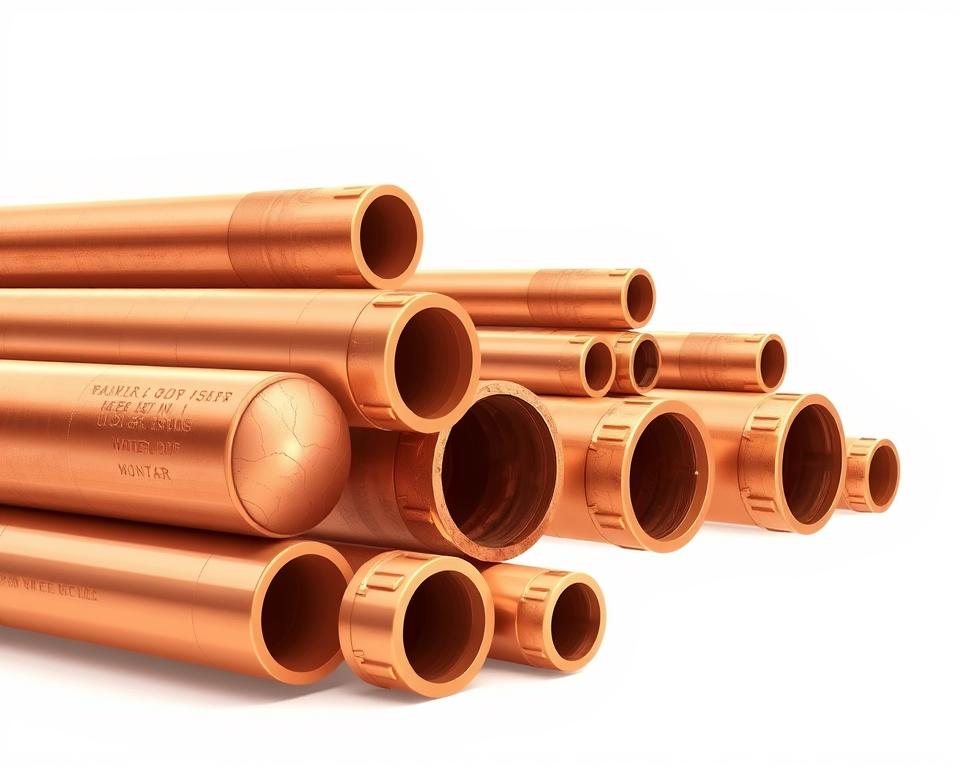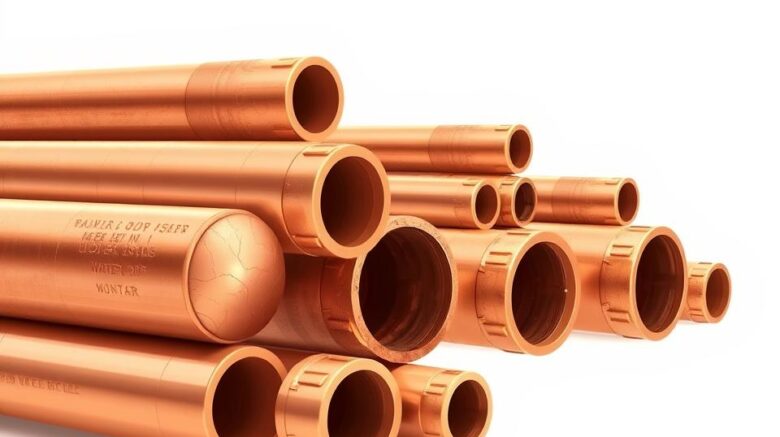Your Guide to Copper Water Line Sizing at Home
It may surprise you that approximately 30% of residential plumbing failures come from improper pipe sizing. Using the proper dimensions helps maintain ideal water pressure and system efficiency. This guide helps homeowners understand the basics of sizing for residential projects.
Determining the right size relies on considerations like required flow and wall measurement. The industry standard copper water line sizes ranges from 1/4″ to 8″ diameters, measured by NPS (Nominal Pipe Size) and actual outer dimensions. Turn to Installation Parts Supply for specialist support to pair your home’s needs with regulation-approved products.
Thanks to its toughness and rust-resistance, copper is still preferred. Whether you’re upgrading existing systems or planning new installations, understanding these fundamentals saves time and prevents costly mistakes.
Significant Notes

- Correct sizing prevents 30% of common plumbing problems
- Standard diameters range from 1/4″ to 8″
- NPS labels don’t match real outer diameters
- Right sizing preserves water pressure and performance
- Copper delivers strength and rust protection
- Professional guidance ensures code compliance
Why Copper Pipes Are Ideal for Your Plumbing?
Plumbing longevity starts with selecting the right material—here’s why copper stands out. Boasting a half-century lifespan and NSF potable-water approval, it’s a go-to for residences. It uniquely blends durability with environmental responsibility.
Durability and Corrosion Resistance
Copper naturally resists rust and chemical damage, outperforming PVC or PEX. Smooth bore reduces friction, keeping water pressure steady. Practical tests confirm decades of leakless performance.
Installation Parts Supply carries certified quality products suited to your project. Although upfront costs rise, less frequent repairs yield savings over time.
Bendability and Freeze Safety
In frost-prone areas, its minor freeze expansion helps avert pipe bursts. This give lowers the likelihood of pricey cold-weather failures. Use alongside suitable insulation for peak frost protection.
Green and Antibacterial Advantages
Being wholly recyclable, it cuts environmental burden. Its germ-killing traits help safeguard against bacterial contamination. For eco-conscious homeowners, it’s a clear win over plastic alternatives.
Understanding Copper Pipe Water Line Sizes and Types
Pipe sizing can baffle homeowners—this section clarifies it. The industry uses Nominal Pipe Size (NPS), which doesn’t match the actual outer dimensions. For example, a 1/2″ NPS has an outer diameter of 0.625″.
Nominal vs. Actual Pipe Dimensions
Nominal sizes act as identifiers, not actual dimensions. Verify the OD itself when buying. Use this quick conversion guide:
- 1/4″ NPS corresponds to 0.375″ OD
- 1/2″ NPS = 0.625″ OD
- 3/4″ nominal → 0.875″ actual
L vs. M vs. K Copper Pipes
Three copper variants lead in home plumbing. Wall gauge dictates where they’re best applied:
- Type L: Light-wall (0.040″ for 1/2″), ideal for most homes.
- Type M: Medium gauge (0.050″ @ 1/2″), for cost and strength balance.
- Type K: Thick-wall (0.060″ @ 1/2″), meant for high-pressure use.
Installation Parts Supply recommends Type M for general plumbing due to its versatility. Larger diameters (over 2″) often require Type K for irrigation or commercial use.
L-Type Copper Pipes: Slim and Adaptable
Home handymen find L-type superbly easy to shape. A slender wall cuts both heft and expense without sacrificing dependability. Available in rigid sticks or soft coils, it adapts to everything from HVAC lines to drain systems.
Where L-Type Excels and Falls Short
Best suited to systems under low pressure. A 0.040″ gauge suits:
- HVAC refrigerant lines
- Drain-waste-vent (DWV) systems
- Residential water supply (below 80 PSI)
High-pressure? Skip L-type and choose K-type instead. Soft coils (up to 50ft) simplify bending around obstacles but require careful handling to prevent kinks.
L-Type Sizing and How to Install
Choose from 1/4″ to 8″ diameters, with these popular options:
| Form | Max Length | Best For |
|---|---|---|
| Rigid | 20ft | Straight runs |
| Coiled | 50ft | Tight spaces |
Beginners will find rigid lengths, as recommended by Installation Parts Supply, the easiest to cut and solder. When tackling big installations, coils mean fewer joints, saving time and leak hazards.
Type M Copper Pipes: The Residential Standard
With cost and strength balanced, M-type is ideal for today’s residences. Medium gauge copes with routine loads yet stays budget-friendly. Approved by NSF for water and gas, it works in kitchens, baths, and heating.
Where M-Type Shines
Perfect for mixed hot/cold service, keeping water pressure uniform. Rigid 12ft lengths suit straight runs, while 100ft coils adapt to tight spaces. Common applications include:
- Drinking water distribution
- Medical gas lines (oxygen, nitrous oxide)
- HVAC refrigerant lines
M-Type Gauge & PSI Ratings
Sits midway between L and K in gauge and strength. Its 0.050″ wall (for 1/2″ NPS) resists bursts up to 150 PSI. See the specs contrast:
| Type | Wall Thickness (1/2″) | Max Pressure | Best For |
|---|---|---|---|
| L | 0.040″ | 80 PSI | Low-pressure DWV |
| M | 0.050″ | 150 PSI | Residential supply |
| K | 0.060″ | 200 PSI | Irrigation |
Installation Parts Supply stocks M-type in all standard sizes. Combine with proper flare connectors for gas lines to secure seals. Leave small expansion joints in hot lines for temperature shifts.
K-Type Copper: Maximum Strength
For ultimate robustness, choose K-type in rigorous settings. Heavy walls plus high PSI capacity suit it to industrial or buried lines. Unlike thinner alternatives, it resists crushing and corrosion in harsh environments.
K-Type for High PSI & Irrigation
K-type thrives in extreme conditions. Its 0.060″ wall thickness (for 1/2″ NPS) handles up to 200 PSI, perfect for:
- Underground irrigation systems
- Commercial HVAC refrigerant lines
- Fire sprinkler networks
When burying, Installation Parts Supply suggests at least 18″ cover. Use compression connectors tightened to 25 ft·lb to seal joints.
Installation Tips for Rigid vs. Coiled Forms
Pick rigid or coil depending on application. Rigid 12ft sticks suit straight runs, while 50ft coils navigate obstacles. Here’s how they stack up:
| Form | Best For | Limitations |
|---|---|---|
| Rigid | High-pressure mains | Requires more fittings |
| Coiled | Trenchless installations | Risk of kinks if bent sharply |
In irrigation layouts, allow 10% for thermal growth. Avoid bending rigid forms without a tube bender—kinks reduce flow efficiency.
Installing and Caring for Copper Pipes
Correct methods deliver years of drip-free operation. Whether you’re a DIY enthusiast or hiring a pro, understanding the basics saves time and avoids headaches. Implement these tips for reliable, enduring installations.
Permanent vs. Temporary Connection Methods
Select the joining style that fits your task. Permanent joints use heat or compression, while temporary options allow adjustments. Compare the pros and cons:
| Method | Pros | Cons | Best For |
|---|---|---|---|
| Soldering | Strong, permanent | Requires skill | Water supply lines |
| Compression | No heat needed | Bulky fittings | Tight spaces |
| Push-Fit | Quick installation | Higher cost | Emergency repairs |
Step-by-Step Soldering Guide
For a flawless joint, follow these steps:
- Use emery cloth to clean both surfaces.
- Coat each piece evenly with flux.
- Heat until the flux bubbles.
- Apply solder to the seam; it will wick in automatically.
Always wear heat-resistant gloves and work in a ventilated area. Find NSF-approved, lead-free solder at Installation Parts Supply for water systems.
Preventing Leaks and Freezing Damage
Use foam insulation on pipes in cold spots. Fit foam sleeves where lines pass exterior walls. Repair advice includes:
- Look for greenish corrosion at joints each year.
- Bracket horizontal stretches every 32 inches to stop drooping.
- Install freeze-proof faucets in cold climates.
Yearly checks spot small problems early. Stash wrenches, cutters, and Teflon tape in your kit for fast repairs.
Conclusion: Selecting the Right Copper Pipe with Installation Parts Supply
With good planning, your plumbing will last—remember these highlights. Choose proper size and type for lasting durability. Remember:
- Type M is best for homes; Type K for demanding uses
- Accurate dimensions keep pressure up and leaks down
- Freeze protection is critical in cold climates
Installation Parts Supply offers expert guidance to simplify choices. Certified solutions with quality warranties keep your plumbing systems running perfectly.
Looking for assistance? Get free sizing charts or book a consultation now. First-time buyers get exclusive discounts—start your project right!
